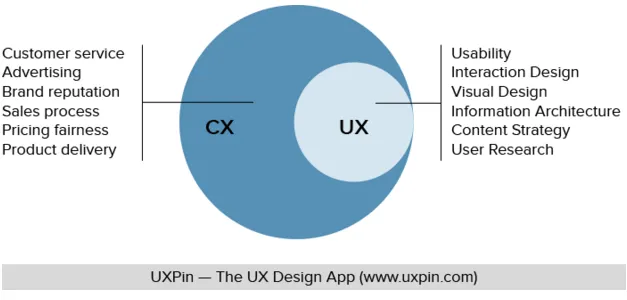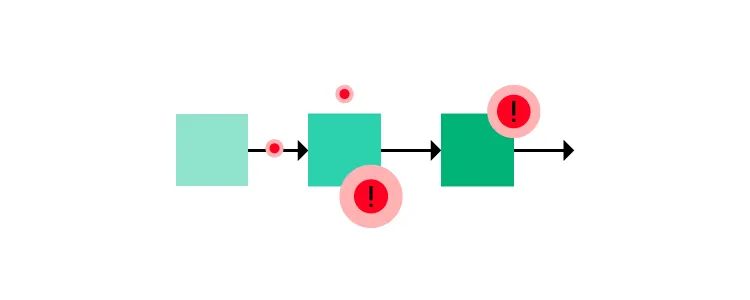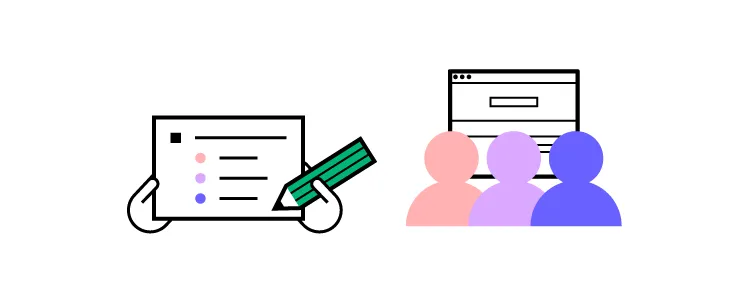Customer Experience vs. User Experience – Why the Difference Matters

Don Norman, the founder of the Nielsen Norman Group and former Apple VP, coined the term user experience or UX in the 90s. Almost two decades later, Tony Hillson from Service Design in New Zealand came up with customer experience or CX.
Many people incorrectly use CX and UX interchangeably, but these describe different levels of user/customer interactions. We explore CX vs. UX, how these differ/intersect, and the metrics teams use to measure and optimize performance.
Create a great customer experience with a good user experience. Switch to UXPin–the world’s most sophisticated design tool. Build better prototypes to solve more problems while identifying valuable business opportunities. Sign up for a free trial to explore UXPin’s advanced features.
What is User Experience (UX)?
UX or user experience describes a user’s journey and interactions with a digital product. Factors impacting user experience include usability, information architecture, navigation, learnability, and visual hierarchy, to name a few.
It’s important to note that users aren’t always customers. For example, website traffic are users, which include customers and visitors. Many digital products offer free plans for users, hoping that these people will convert to becoming paying customers. Optimizing your UX creates a positive customer experience while increasing the likelihood of converting leads.
What is Customer Experience (CX)?
Customer experience describes a customer’s holistic relationship with a brand across multiple touchpoints–including a product’s user experience. The customer experience extends beyond products and UX to include:
- Buyer’s journey–the process of paying for goods and services
- Pricing fairness
- Marketing communications
- Brand reputation–are people proud to use your products?
- Customer service interactions
- The sales process–purchases, upsells, and retention
- Social media engagement
- In-store experiences (for retail and physical products)
- Product delivery–physical (shipping, packaging, etc.) and digital
Within many of these touchpoints are user experiences organizations must manage and optimize.
CX vs. UX – Differences in Focus and Responsibilities
Areas of focus
This simple diagram demonstrates the differences between UX and CX. As you can see, CX encapsulates the user experience. CX is a high-level initiative, whereas UX focuses on digital touchpoints–i.e., website, applications, devices, etc.

Tesla is a great company to demonstrate these different areas of focus. Telsa’s customer experience may look something like this:
- Purchasing a car–including interactions with salespeople
- Taking delivery
- Interacting with customer service
- Charging the vehicle
- Servicing
- The driving experience
- Attending Telsa events
- Vehicle servicing and updates
Within these touchpoints are multiple user experiences:
- Using Telsa’s website to purchase a vehicle
- Any Telsa native or web applications
- Using the car’s digital automotive user interfaces
As you can see, many customer experiences have little or nothing to do with Telsa’s user experiences.

Areas of responsibilities
CX and UX differ in ownership and responsibility:
- User experience: product development teams (product managers, engineers, UX designers)
- Customer experience: marketing and customer service teams
While these responsibilities are a generalization and may differ depending on the organization, the key distinction between responsibilities is:
- User experience: those in charge of technology and digital user interfaces
- Customer experience: those who directly or indirectly communicate with customers
CX vs. UX – Similarities
Human-centered
CX and UX use human-centered research and personas to understand users/customers and their journeys. Teams use similar methods for collecting this data, including:
- Product/website analytics
- Interviews
- Surveys
- Customer support tickets
- User profile/account data
UX designers will also collect data through usability testing, which they may share with other teams.

Retention
CX and UX aim to engage and retain users to create lasting business value. Teams do this by solving problems and creating positive experiences. For example:
- A customer purchases a product through a brand’s website. The user flow from selecting the product to checkout is effortless, creating a positive user experience, meaning the customer is likely to return.
- The customer receives their parcel within 48 hours, but it’s not the correct size. The company included return packaging, so the customer simply drops it in the bag provided and uses the brand’s website (user experience) to book a return collection.
- As soon as the courier collects the parcel, the company credits the customer’s account, and they can purchase the correct size. This positive customer experience increases the likelihood the brand will retain this customer.
Personas and journey mapping
UX and CX use personas and journey mapping to understand their audiences and how they complete tasks. While the structure and focus might differ, the tools and methods are similar.
Understanding UX vs. CX Performance Metrics
Here are a few examples of UX and CX metrics and how marketing and product teams might use them.
Customer lifetime value (CLV)
Customer lifetime value (CLV) is the company’s average expected revenue from a single customer during their business relationship. CX professionals use this metric to guide budget and marketing decisions.
UX teams typically won’t use CLV because it has no direct connection to understanding user behavior or building empathy. UX metrics are more valuable to UX designers when they provide insights into how users think and feel.
Net Promoter Score (NPS)
Net promoter score is a critical metric most marketing managers/CMOs monitor closely. NPS indicates customer satisfaction and how likely people are to recommend your brand.
Organizations use NPS testing in digital products and real-world experiences. We often see physical NPS systems in airport bathrooms or retail stores asking to “rate your experience” with three faces representing happy, satisfied/content, and poor.
UX designers use NPS scores for digital products to identify issues. For example, if people repeatedly score a specific feature poorly, UX teams can research to determine the problem.
Churn rate
Churn rate is another critical CX metric because it tells organizations the rate at which people stop doing business with you over a specific period, represented as a percentage.
UX teams typically only review churn rates if customers leave a company due to technical issues and poor user experiences.
Error rate
Error rate is a crucial UX metric because it tells designers where users get stuck or can’t complete tasks, resulting in a poor user experience.
CX professionals don’t necessarily follow error rates. Still, this metric can directly impact churn rates and NPS, at which point marketing and UX teams must collaborate to find a solution fast!
Success rate
The success rate (completion rate) defines how many people complete a specific task. This metric is a gauge for UX designers, particularly after a new release. If the success rate improves, the design is successful; if it drops, there’s a problem.
CX professionals don’t typically follow success rates, but, like error rates, it can affect other CX metrics.
Conversion rate
Conversion rate is another crucial CX metric indicating the percentage of traffic/non-paying users converting to paying customers. For example, if 100 people visit a website and 10 purchase a product, your conversion rate is 10%.
UX teams also use conversions against designs and new releases as a success metric. For example, if the design team fixes a problem with an eCommerce checkout, the conversion rate will tell them whether the new release improves conversions.
How Can UX Improve CX?
UX is one of the strongest influences on the overall CX. If customers can’t complete tasks or solve problems using a brand’s app, website, or other digital touchpoints, this is a negative customer experience that ultimately results in higher churn, fewer conversions, and lowers CLV.
Make customer feedback easy
Make it easy for customers to contact customer service or find help. Add a contact link to your website’s footer and include a help screen in your desktop and mobile apps.
Design seamless cross-platform experiences
Users must be able to complete the same functions across multiple devices and operating systems. Ever wanted to complete a task in a brand’s mobile app, but they find you can only do this via the web application?
This restriction causes frustration for users and may have negative consequences for them, resulting in a poor user experience and customer experience.
Optimize performance
Slow load times are incredibly frustrating for users. If users have to constantly wait for screens to load or actions to complete, they will lose trust in the product/website and find a better alternative. UX designers must collaborate with engineering teams to find solutions to improve product performance and reduce friction in completing tasks.
Cross-functional collaboration
Behind designing, look for ways to collaborate and share information to improve customer experiences with other departments. For example, UX and CX professionals can share data to enrich one another’s personas and journey maps.
Designers can also include marketing team members in design sprints to gain more customer experience insights and improve design projects.
Advocate for design
Design advocacy is a strategy for educating an organization about design thinking and user experience. Design advocates also promote wins for the department–like demonstrating how a design project improved CX metrics.
Design advocacy is essential because it increases the department’s value, making it easier to secure resources for better tools and systems, ultimately improving user experience and CX.
Improve your user experiences across every touchpoint with UXPin. Sign up for a free trial to discover how code-based design can revolutionize your product development workflows to deliver better user experiences to your customers.




